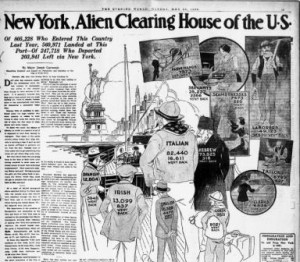This is a guest post by Meg Steele, who works with K-12 teachers at the Library of Congress, and Mary J. Johnson, an educational consultant to the Library of Congress.
Teachers in nearly every state are implementing the Common Core State Standards, mapping existing curriculum to the standards, and creating, revising or tweaking classroom strategies and practices.
Despite their relative newness, some teachers have said of the Common Core: “Oh, I already do this!” We here on the education staff at the Library of Congress had the same reaction. The very skills required for effective teaching and learning with primary sources—skills that are core to the Library’s K-12 materials—are also central to the CCSS.
So, where exactly do primary sources fit into the CCSS? We’d like to highlight three ways that stand out:
- First, the Common Core State Standards explicitly state that students will be adept at reading both primary and secondary sources. Primary sources—the raw materials of history—require students to look for details and synthesize ideas. Comparing and contrasting primary sources with secondary sources lets students construct their own understanding, and encourages them to question prior knowledge.
- Second, the CCSS emphasize the use of informational text. Primary sources offer a range of types of informational texts that will engage students: books and articles, of course, but also newspapers, manuscripts, speeches, letters, diaries and formats with visual elements to “read” such as maps, photographs, cartoons, film, etc. The immigration article from New York’s The Evening World (5/20/22)—and thousands of others available from the Library’s Web site—is just one example teachers will find with simple key word searches.
- Third, the Standards emphasize reading skills that parallel best practices for using primary sources. When students analyze primary sources, they make observations and inferences backed by evidence about vocabulary, point of view, cause and effect, and more. Primary sources drive students to wrestle with contradictions, ask questions, and develop a research strategy to find answers, leading them to other primary and secondary sources.
How do resources from the Library of Congress fit in? Our free teacher resources and professional development are all targeted at building primary source analysis skills.
For a quick start: Here, you’ll find analysis guides that support teachers in generating lesson frameworks and guiding questions aligned with Common Core. See the analysis guides in action in an online professional development module on analyzing primary sources. Use the guides hand in hand with our primary source sets, which offer a curated set of informational texts of varied complexity, and accessible to students. You can, of course, select additional primary sources to meet your teaching objectives.
The Library’s primer on “Using Primary Sources” delves deeper into developing critical thinking skills with primary sources. The Fall 2012 Teaching with Primary Sources Journal offers even more strategies and resources on Primary Sources and the Common Core State Standards.
Have you used primary sources to align with the Common Core? Share your experience in the comments so we can support other teachers engaged in this work right now.

